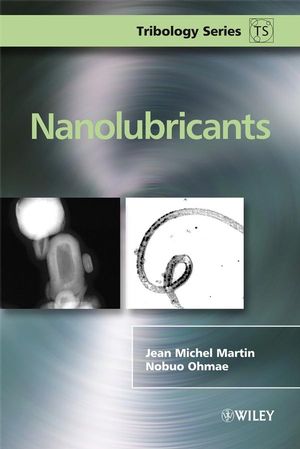NanolubricantsISBN: 978-0-470-06552-5
Hardcover
246 pages
May 2008
 |
||||||
List of Acronyms.
1 Colloidal Lubrication (Jean Michel Martin and Nobuo Ohmae).
1.1 Stability of Colloids Dispersed in a Base Oil.
1.2 Lubrication by Micellar Systems.
1.3 Lubrication by Metallic Nanoparticles.
1.4 Colloids Embedded in a Coating.
References.
2 Nanoparticles Made of Metal Dichalcogenides (Lucile Joly-Pottuz and Fabrice Dassenoy).
2.1 Tribological Properties of 2H-MoS2.
2.2 IF-MoS2 and IF-WS2 Fullerene-like Nanoparticles.
2.3 IF-MoS2 and IF-WS2 as Additives in Boundary Lubrication.
2.3.1 IF-MoS2.
2.3.2 IF-WS2.
2.3.3 Other Fullerenes.
2.4 NT-MoS2 and NT-WS2 Nanotubes as Lubricant Additives.
2.5 Lubrication by a Mixture of Fullerenes.
2.6 Tribological Properties of Mo-S-I Nanowires.
2.6.1 Influence of the Nanowire Concentration in PAO on the Tribological Properties.
2.7 Raman Tribometry on IF-MS2.
2.7.1 In situ Observation of the Structures in the Interface.
2.7.2 Raman Tribometry.
2.8 Lubrication Mechanism of IF-MS2: ‘A Drug Delivery’ Model.
2.9 Conclusion 88
Acknowledgements.
References.
3 Carbon-Based Nanolubricants (Lucile Joly-Pottuz and Nobuo Ohmae).
3.1 Graphite Onion Synthesis and Characterization.
3.2 Tribological Properties of Different Carbon Onions.
3.3 Possible Lubrication Mechanism of Carbon Onions.
3.4 Nanotube Synthesis and Characterization.
3.5 Friction-Reducing and Antiwear Properties of Different Nanotubes.
3.5.1 SWNTs.
3.5.2 DWNTs.
3.5.3 MWNTs.
3.6 Possible Mechanism of Action of the Nanotubes.
3.7 Conclusion.
Acknowledgements.
References.
4 Reverse Micelles and Encapsulated Nanoparticle Approaches (Jean Louis Mansot and Jean Michel Martin).
4.1 Introduction.
4.2 Overview of the Structures of Stoichiometric and Overbased Soap Additives.
4.2.1 Dynamic Organic Micelles.
4.2.2 Dynamic Soap Micelles.
4.2.3 Encapsulated Nano-Sized Particles, also Called ‘Overbased Reverse Micelles’.
4.3 Behaviour of the Micelles at the Solid–Liquid Interface.
4.4 Tribologic Properties of Colloidal Systems.
4.4.1 Friction Reduction Properties of Micelles Related to Their Structure.
4.4.2 Antiwear Action Mechanisms of Colloidal Systems.
4.4.3 Nature and Structure of Antiwear Films Obtained with Strontium and Calcium Compounds.
4.4.4 Associated Antifriction and Antiwear Actions in Tribological Behaviour of Colloidal additives.
4.5 Conclusion and Perspectives.
References.
5 Nanolubricants Made of Metals (Weimin Liu and Xiaobo Wang).
5.1 Introduction.
5.2 Nanolubricants Made of Coinage Metal Nanoparticles.
5.2.1 Organic Compound Surface-Capped Copper Nanoparticles as Oil Additives.
5.2.2 Copper Nanoparticles Passivated by Carbon Film Used as Oil Additives.
5.3 Nanolubricants Made of Low Melting Point Metal Nanoparticles.
5.3.1 Nanolubricants of Indium, Tin and Bismuth via the Direct Solution-Dispersing Method.
5.3.2 Nanolubricants of Lead and Bismuth via the Surfactant-Assisted Solution-Dispersing Method.
5.4 Nanolubricants Made of Low Melting Point Metal Alloy Nanoparticles.
5.4.1 In-Sn, Bi-In and Pb-Bi Nanoparticles Prepared by the Direct Solution-Dispersing Method.
5.4.2 Sn-Bi and Sn-Cd Alloy Nanoparticles Prepared by the Ultrasonic-Assistant Solution-Dispersing Method.
5.5 Mechanism of Metal Nanoparticles Used as Oil Additives.
5.6 Perspective.
References.
6 Boron-Based Solid Nanolubricants and Lubrication Additives (Ali Erdemir).
6.1 Introduction.
6.1.1 Brief Overview of Lubrication Mechanisms of Solid Lubricants.
6.1.2 Recent Advances in Solid Lubrication.
6.2 Brief Overview of Boron and Its Self-Lubricating Compounds.
6.2.1 Hexagonal Boron Nitride.
6.2.2 Boric Acid.
6.3 Lubrication by Colloidal Boric Acid Nanoparticles and Other Boron Compounds.
6.3.1 Preparation of Oils with Nano-Boric Acid Powders.
6.3.2 Lubrication Performance of Various Oils Containing Nano-boric Acid Particles.
6.4 Lubrication Mechanism of Nano-Boric Acid Colloids in Oils.
6.5 Summary.
Acknowledgement.
References.
Appendix Tribometers Used for the Studies of Chapters 2 and 3.
A.1 Environmental Pin-on-Flat Tribometer.
A.2 Mobile Pin-on-Flat Tribometer.
A.3 Ultrahigh Vacuum Tribometer.
Reference.
Index.



